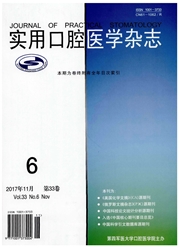

 中文摘要:
中文摘要:
目的:分析摇倚弓角度和弧形深度的变化对前后牙垂直向力的影响。方法:采用ANSYS有限元软件建立下颌牙列、牙周支持组织以及不同角度、不同弧形深度的0.46mm×0.64mm不锈钢下颌杯准弓形摇椅弓的三维有限元模型,将摇倚弓变形前后的位移差作为载施加于有限元模型,通过多次迭代使其满足变形协调条件,计算出牙齿垂直方向的受力情况。结果:获得较理想的三维有限元模型。摇椅弓对牙齿产生的作用力在尖牙、第二前磨牙和磨牙处较大,在切牙处较小。当摇椅弓角度不变时,随着摇椅弓弧形深度的增加,切牙和磨牙压低力增加,尖牙经历一个由升高到压低的过程,前磨牙经历一个由压低到升高的过程。当摇椅弓弧形深度不变时,随着摇椅弓角度增加,切牙和磨牙压低力增加,尖牙经历由压低到升高的过程。结论:摇椅弓角度和弧形深度的变化对施于牙齿的垂直向力产生显著影响。
 英文摘要:
英文摘要:
Objective:To analyze the perpendicular force on each tooth produced by the reverse-curve arch wires of various angles and depths using the method of 3-D finite element (3-D FEM ) analysis. Methods:3-D FEM models of lower teeth, periodontal ligaments and alveolar hone as well as the 0.46 mm×0.64 mm inch stainless steel reversecurve arch wires with different angles and depths were developed with the ANSYS finite element software, and the displacements of deformation of the reverse-curve arch wires were established on the models. Results:A ideal 3-D FEM was construct,including 2 709 elements and 1 969 nodes. The depth and angle of the reverse-curve arch wires produced obvious effect on the force exerted to teeth, and they could alter both the strength and the direction of the force. The force was mainly loaded on the canines, the second premolars and the molars, while less loaded on the incisors. Affected by the reverse-curve arch wires, the perpendicular force on the incisors were brought intrusively and on the molars were brought intrusively and distal upright; however, the canines and the bicuspids, in the perpendicular direction, moved along with the transformation of the angle and depth of the reverse-curve arch wires. When the angle of reverse-curve arch wires was fixed, the intrusive force on the incisors and molars was increased along with the increase of depth of the reverse-curve arch wires. Perpendicularly, the canines underwent a process from extrusion to intrusion, while the bicuspids were from intrusion to extrusion, When the depth of reverse-curve arch wires was fixed, the intrusive force on the incisors and molars was increased along with the increase of angle of the reverse-curve arch wires. The canines underwent a process from intrusion to extrusion. Conclusion:The variation of the angle and depth of the reverse-eurve arch wires may produce evident effect on the force exerted to teeth.
 同期刊论文项目
同期刊论文项目
 同项目期刊论文
同项目期刊论文
 期刊信息
期刊信息
